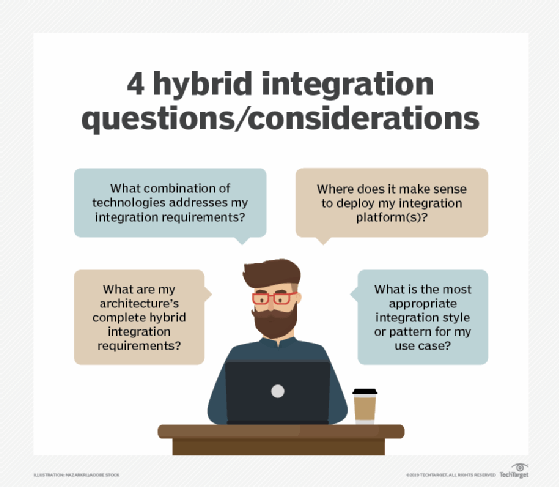
freshidea - Fotolia
The 3 fundamentals of hybrid cloud architecture management
When an enterprise chooses hybrid cloud, it needs to ensure the application harmonizes between the two environments. Review these three tips on architecture, integration and APIs.
Hybrid cloud continues to rise in popularity since it promises the best of both worlds; the data center aspect offers more control over resources while a public cloud provides scalability and agility to the apps you deploy. However, enterprises need to ensure their applications are well-suited for a hybrid architecture.
Follow these quick hybrid architecture and integration tips to ensure both your apps and developers can live comfortably in a hybrid cloud architecture.
Key management practices for a hybrid cloud architecture
Applications that move between on-premises systems and public cloud can encounter bottlenecks and performance issues because of various factors, such as improper server alignment and mismanagement of distributed storage.
Review these five best practices to ensure that your hybrid cloud architecture can integrate properly with your microservices apps:
- Think in workloads: In hybrid cloud, a workload includes network, hosting and web service features that the application may use. However, this deployment model may not be suited for all applications, specifically those that need high-performance network storage at all times.
- Examine load balancing: Not all load-balancing services in the cloud extend beyond a particular cloud vendor's environment, and this limitation can cause bottlenecks and latency issues for data that moves across various cloud boundaries. To combat this, look to service mesh tools like Istio, which provide a way for microservices apps to balance workloads across multiple cloud platforms. And to manage large-scale cloud workloads, global server load balancing systems help balance workloads across servers located in multiple geographic regions and prevent cases of one server crumbling from an overload.
- Pick the right tools: Microservices usually deploy on containers in cloud, so enterprises should review configuration management tools, such as Helm and Spinnaker, as well as automation tools, such as Rundeck. These tools provide an abstracted infrastructure management layer that can provide better control over containers in constant motion.
- Set a standard: To ease portability and maintain uniform policies, find a cloud orchestration tool that uses a common language to serve as a contractor between network devices and the resources that interact with them. Popular standards for cloud-based workloads include the Topology and Orchestration Specification for Cloud Applications (TOSCA) and the Network Configuration Protocol (NETCONF).
- Monitor costs: Crossing between clouds can quickly rack up resource management fees, so it is important to find a tool that can help you monitor your cloud hosting costs. Cloudyn and CloudHealth are two popular tools that can track areas of overspending.
Two fundamental approaches to hybrid cloud integration
To integrate data center hosting and public cloud services, developers can choose between two main strategies: treat cloud as the front-end application hosting point or turn both the data center and the cloud into an elastic resource pool. This decision will dictate the toolset you use to manage and monitor application components.
A public cloud front-end hosting strategy uses the cloud provider's hosting service to manage your app deployment, which means developers can manage back-end infrastructure on a separate platform from the deployed apps. This can lead to integration issues since the hosting environments are managed separately and developers do not have to manually configure app compatibility with the data center.
However, complications can arise when front-end components need to access data sitting in on-premises databases. To mitigate this, you must implement an additional APM strategy that sets easy-to-identify trace points to monitor communication between the front-end app and the data center.

In a unified resource pool strategy, the cloud and data center share a hosting pool for an app. Abstraction tools, such as Apache Mesos, can help create resource pools that link your tools and provide support for scaling and failover.
The drawback is that enterprises will have to integrate their existing management and deployment tools with these abstraction tools, rather than directly with the hosting or cloud resources themselves. This will add one layer of management complexity that may take a toll on your developers.
How to design APIs for hybrid cloud architecture
A hybrid cloud architecture using microservices needs to meet basic requirements for API support, including scalability and discovery capabilities. Make sure to create a common middleware framework that creates a uniform platform for microservices deployment and federates shared components.
Enterprises can also choose a resource pool model for a hybrid cloud architecture. These components will deploy in both a public cloud and the data center, but they require you to maintain strict control over API communication and implementation processes. Luckily, service mesh tools like Istio and Linkerd can help string together these hybrid environments.
Finally, consider if any of your applications perform real-world event processing or are based in reactive programming. These applications demand consistently high performance and large amounts of processing power. While the above-mentioned frameworks may be capable of handling event-driven apps, tools like Akka and language frameworks like Micronaut are designed to provide the performance support these apps need.







